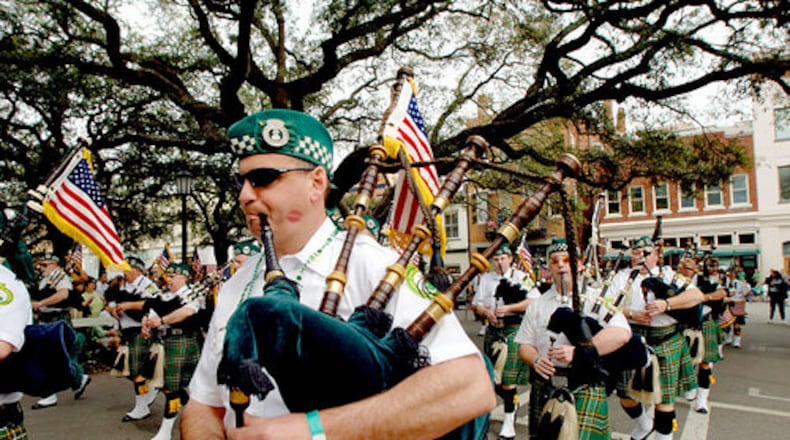One day a year, Savannah goes green — and leaves the rest of America green with envy.
Never more so than in 2024.
Savannah marks the 200th anniversary of the city’s biggest tradition, the St. Patrick’s Day Parade, held this year on Saturday, March 16. The celebration dates to 1824, when a local Irish society, the Hibernians, invited the public to join them for a procession and reception for a charismatic Roman Catholic bishop from Charleston, South Carolina.
The parade quickly became a custom, and today Savannah’s St. Patrick’s Day observance is among the largest and oldest celebrations of Irish heritage in the United States. The family-friendly event takes over the city’s historic district with a march featuring bands, troops, floats and Alee Shriner Clubs snaking along a 3-mile route.
Here’s all you need to know about the 2024 parade:
Why is Savannah an Irish American enclave?
The port city was a destination for Irish immigrants almost from its founding. Georgia’s second governor, Henry Ellis, was Irish, and Savannah’s Irish population grew quickly during Colonial times. Another wave of Irish arrived in the 1840s and 1850s during the potato famine, with a strong concentration of immigrants from County Wexford, located on Ireland’s southwestern tip. Savannah continued to attract Irish laborers as the city’s growth surged during Reconstruction and the Industrial Revolution.
Why is the parade not on St. Patrick’s Day this year?
St. Patrick’s Day is first and foremost a religious celebration, and the parade is typically held on the feast day itself, March 17. The lone exception is when March 17 falls on a Sunday, as it does this year. Out of respect for the church, the parade is staged a day early on March 16.
What’s the attendance?
Estimates are often greatly exaggerated, but the crowds for Saturday parades tend be among the largest and can reach more than 100,000. Celebrants line the sidewalks on both sides of the lengthy route and also the city’s six public squares that the march passes. The parade starts at 10:15 a.m. and typically lasts into the early afternoon.
What if I want to go?
Get up early. Parade veterans claim curbside sidewalk spots the day before by setting up chairs and arriving in the pre-dawn hours to guard their space. Square squatting is a different matter — the city government closes the squares along the route the day before and doesn’t open them until 6 a.m. on parade day. This results in a mad rush to stake out territory, transforming the pristine greenspaces into a tailgate tent city in a matter of minutes.
For those less inclined to wake early and jostle for space, bleacher seating is available for purchase at several points along the parade route, including along Bay Street, next to the Colonial Cemetery on Abercorn Street and in front of the Basilica Cathedral of St. John the Baptist near Lafayette Square. Seating for large groups is also available and can accommodate groups up to 50 people.
Credit: Stephen Morton / AP
Credit: Stephen Morton / AP
Who and what will you see in the parade?
The parade’s origins as a procession of Irish societies and families persists. Organized by the Savannah St. Patrick’s Day Committee, the 800-member group elects a grand marshal from among its ranks to lead the parade every year. Behind him march past grand marshals, a contingent of committee members, Irish families who trace their Savannah roots a century or more, and leaders of the many Irish societies, including the founding Hibernians.
Aside from the Savannah Irish, the parade lineup includes bagpipe bands from across the country, fife and drum corps, high school marching bands, and even a few rock ‘n’ roll acts playing from floats. There are also dozens of commercial entries, highlighted this year by the Budweiser Clydesdales, and appearances by University of Georgia mascot UGA XI, a Savannah resident, and Georgia Southern’s bald eagle, Freedom.
Savannah-area military installations, such as Fort Stewart, send troops to march. Every student from Benedictine Military School, a local boys high school, walks the route as well, their uniforms crisp and black shoes gleaming. Elected officials typically participate.
Bringing up the parade’s rear are a number of Shriner’s Club units, each with their own theme, from pirates to Keystone Kops. A crowd favorite is the mini-car unit, with large men crammed into tricked-out go-karts spinning choreographed routines at most intersections along the route.
Credit: Stephen Morton / AP
Credit: Stephen Morton / AP
What’s the deal with the grand marshal?
Every longtime Savannah Irishman, especially those born and raised in the city, dreams of leading the annual parade. Applicants must be at least 55 years old, male — the parade committee is for men only — and be able to trace his ancestry to Ireland. Candidates spend decades building their profile through service to the parade committee, in Irish and Catholic societies such as the Knights of Columbus, and other community organizations.
Often the grand marshal is the son, grandson or great-grandson of a past grand marshal. The 2024 grand marshal, John Forbes, is the son of the 1998 grand marshal.
The Parade Committee elects a new grand marshal every February in a festive, members-only election. In a nod to the parade’s connection to Catholicism, each vote is followed by a burning of ballots, with the smoke piped outside the polling venue. Just as white smoke signals the election of a new pope at the Vatican, green smoke announces the crowning of a new grand marshal.
The grand marshal presides over a series of events prior to the parade and is the committee’s formal spokesman. He works with the general chairman, who leads the parade’s executive committee and is the de facto director. Tim Mahoney, a local sales professional, is the 2024 general chairman.
What to bring to the parade?
Patience, hydrating beverages and comfort items, such as collapsible chairs and sunscreen. The crowds are thick and the imbibing of adult beverages begins early, leading to frayed nerves. Having something to sit on and rest is important, given the parade stretches from the midmorning to the early afternoon.
Veterans treat the St. Patrick’s Day Parade like an all-day picnic, complete with breakfast and lunch spreads. Open containers of alcohol are legal in downtown Savannah so long as the beer, wine or spirits are in a cup. Coolers to keep food and drinks cold are permitted, although throwaway coolers, such as those made from Styrofoam, are banned.
What to wear?
Lots of green and lots of layers. Savannah’s weather tends to be mild in mid-March, but temperatures often swing by as much as 25 degrees between sunrise and midday, so dress accordingly. Sneakers or comfortable walking shoes are advised as attendees typically must walk several blocks — or more — from parking areas or drop-off spots to the parade route.
Sunglasses and hats are must-pack accessories. And donning beaded necklaces and other Irish “flair” items will make you look like a local.
Credit: Russ Bynum
Credit: Russ Bynum
You mentioned parking …
The availability of parking is in direct correlation to the time of your arrival. The closer to the start of the parade, the farther away the parking spot. For on-street parking, be sure to follow the posted instructions. Never park on the inside of a downtown square, even those far away from the parade route, because firetrucks and other emergency vehicles with wide turning radiuses use the streets around these squares to respond to situations on parade day. You will be towed.
Parking in municipal garages and surface lots are open, although those close to the parade route will be difficult to access after 8 a.m. as streets close down.
Ride-sharing services such as Uber and Lyft and shuttles operated by Chatham Area Transit run throughout the day and pick up and drop off passengers at designated points near the parade route.
When nature calls?
Unless you’ve been training your bladder for months, you will need a bathroom at some point during your parade visit. Only at the Savannah St. Patrick’s Day Parade do attendees bring their own port-a-johns. Veterans rent the plastic outhouses for a few days, load them on a tow-behind trailer or the back of a pickup truck and park them near the route the night before the parade. But be aware: These “pottywagons” aren’t for general public use.
Less-prepared attendees are serviced by hundreds of similar portable toilets supplied by the city and positioned on the street at several points near the parade route. It is a BYOSS situation — bring your own sanitizing supplies. There are also public restrooms at Forsyth Park, Ellis Square and the River Street Visitors Information Center.
Even with all the outhouse options, public urination offenses typically top the police arrest blotter each St. Patrick’s Day.
What’s this I hear about kissing?
The old adage “kiss me, I’m Irish” takes on new meaning during the St. Patrick’s Day Parade, with many a marcher’s cheek decorated by the telltale leave-behind of a fat smooch. Kissing participants is a long-standing tradition, but the U.S. Army asks that wandering lips stay away from their soldiers as they march in the parade.
This typically means more lipstick action for the Benedictine Military School boys as well as the bagpipers and other performers.
Credit: Stephen B. Morton
Credit: Stephen B. Morton
What about getting some religion?
The St. Patrick’s Day festivities always begin with a morning Mass at the Cathedral Basilica of St. John the Baptist, located along the parade route on Abercorn Street. Get there early — the French Gothic-style cathedral seats thousands but fills up well before the celebration starts at 8 a.m. Many pew rows are reserved for dignitaries and others involved in the parade.
The service lasts about an hour and is a full Catholic Mass with Communion. Following the celebration, Bishop Stephen Parkes will give the grand marshal a blessing.
What about breakfast?
Downtown Savannah has an abundance of coffee shops, bakeries and breakfast restaurants, and most historic district hotels have parade day buffets. But those in search of a true Savannah local experience should check out the annual pancake breakfast at Wesley Monumental United Methodist Church. The church is on the parade route across from Taylor Square at 429 Abercorn St. Proceeds from the breakfast, which begins at 7 a.m., go toward the church’s youth programs and mission trips.
Does the party end with the parade?
Certainly not, although the celebration gets less family-friendly as the parade route empties and the sun sets. River Street and nearby City Market are the epicenters, although the party spills across most of downtown and farther south along Bull Street into the Starland District.
About the Author
Keep Reading
The Latest
Featured






